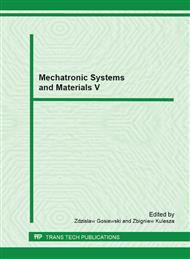[1]
Th. Ardelt, Verfahrensvergleich Planschleifen mit Planetenkinematik-Planparallelläppen, IDR, 35 (2001) 3, pp.214-224.
Google Scholar
[2]
A. Barylski, Charging of the cast iron lapping tools, Sci. Bull. Rzeszow Univ. Technol., 193 (2002), Mechanics 58, pp.53-56.
Google Scholar
[3]
A. Barylski, M. Deja, Calculation of flatness errors formed on the tool during finishing machining by lapping, Int. J. of Applied Mechanics and Engineering, 7 (2002), special issue SITC 2002, pp.291-296.
Google Scholar
[4]
A. Barylski, Lapping of ceramics using metallic-abrasive lapping tools, in: Proceedings of the 17th Annual Meeting the American Society for Precision Engineering, Scottsdale (2000), pp.110-113.
Google Scholar
[5]
A. Barylski, Lapping of flat surfaces with two-metallic tools, in: Proceedings of The Eighteenth Annual Meeting the American Society for Precision Engineering, Portland (2003), pp.571-574.
Google Scholar
[6]
A. Barylski, Simulation models of non-traditional kinematic systems of lapping machines for planes, in: (CD) 16th International Conference on Production Research Production and technology for the benefit of mankind, protecting the nature and life on the earth, ICPR-16. Prague, Czech. Tech. Univ. (2001).
Google Scholar
[7]
A. Barylski, Tendency of flat surfaces lapping technology development, in: II Sympozjum Wybrane problemy projektowania procesów technologicznych, Sopot: Pol. Gdań. Wydz. Mech. Kat. TMiAP (2004), pp.171-182 (in Polish).
Google Scholar
[8]
A. Barylski, Application of artificial bases method in study of removal rate of ceramic elements, Górnictwo Odkrywkowe, 2-3 (2003), pp.157-159 (in Polish).
Google Scholar
[9]
R. Egger, D. Preising, V. Mackensen, Wie Läppen, Maschine u. Werkzeuge, 1-2 (1999), pp.69-71.
Google Scholar
[10]
H.H. Gatzen, Rigid disk slider micromachining challenges to met microtribology needs, Tribology International, 33 (2000) pp.337-342.
DOI: 10.1016/s0301-679x(00)00050-5
Google Scholar
[11]
T. Rehfeldt, Läppen, Feinschleifen, Flachhonen, Wirtschaftlicher Einsatz neuer Bearbeitungs-technologien, Jahrbuch Schleifen, Honen, Läppen und Polieren, Essen, Vulkan (2000), 59 Auflage.
DOI: 10.1002/maco.19790301019
Google Scholar
[12]
G. Spur, Keramikbearbeitung. Schlefen, Honen, Läppen, Abtragen, Műnchen, Carl Hanser Verl. (1989).
Google Scholar
[13]
A.W. Stähli, Flat honing with diamond or CBN grinding disc, IDR, 1 (2000) pp.9-13.
Google Scholar


